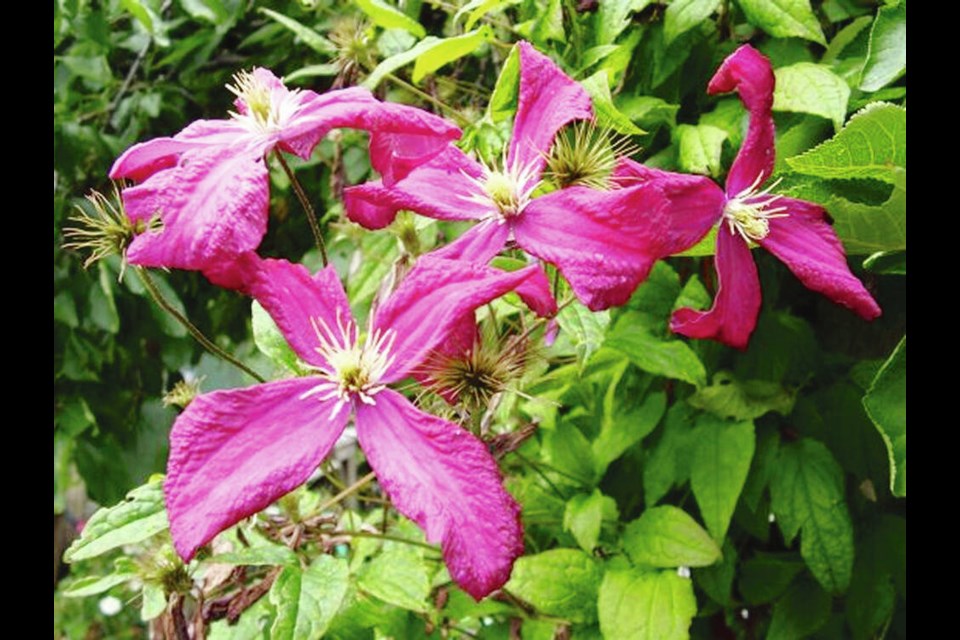Dear Helen: We have a Clematis armandii that has gone out of control. The rampant vine needs so much pruning that we have decided to remove it. Can you recommend a replacement vine that would be easy to maintain?
P.P.
This question arises often in my mail, and I have the same issue with the Armandii in my garden. I love the early flowers, but the evergreen vine is such a rampant grower that it is hard to keep under control without fairly drastic pruning.
If you do not require another vine that is evergreen, I would recommend one of the small-flowering, summer-blooming clematis varieties from among the many in the Clematis viticella species.
Among them, Mme Julia Correvon is a star. This vine bears wine-red flowers all summer. It grows to around four metres high.
The Viticellas are easy to manage. Because they bloom on the current year’s growth, they can simply be cut down close to the ground in late winter to make way for new spring growth to carry the summer’s flowers.
Though they can be planted in autumn, spring is a the preferred time for purchasing and moving a new clematis into a garden.
Dear Helen: In a recent column you wrote about cutting heathers back lightly right after the plants have finished flowering. If you grow heathers, how do you manage this? Do you use hand pruners? That’s the only tool I have for the job and I have many large heathers. The cutting back is an arduous, time-consuming challenge. Can you think of a way to make it easier?
T.G.
I have several large heather plantings, which for years I kept cut back using hand pruners (secateurs), until a gardening friend introduced me to her long-handled shears. After trying out her shears, I acquired a pair, which I have found to be a gardening godsend with many uses as they save wear on over-used thumb joints and wrists.
The shears make short work of many pruning projects, including tidying heathers that have finished blooming. I use them also to chop materials for composting. This helps to accelerate decomposition as smaller pieces break down faster than larger ones.
Dear Helen: Your new email address reminded me of a question I’d meant to ask you. Also because of the new email, I realized your name is not spelled the same as the nut tree. My question: The gorgeous blue hydrangea I bought a few years ago produces only pink blossoms, despite my adding used coffee grounds and aluminum sulphate to acidify the soil. The shrub is located next to a concrete wall, which I was told might be leaching lime into the soil.
A.L.
Whenever giving my name I always spell it out, to let people know they are dealing with a different kind of nut.
Because of the concrete wall next to the hydrangea, it is likely that the concrete is constantly leaching lime into the soil, which means than you will need to keep up with adding acidifying amendments to counter the alkaline leaching.
Coffee grounds help to acidify soils and aluminum sulphate is often recommended for the purpose though I prefer to use simple garden sulphur. I always have a small container of this powdered sulphur in the garden shed, to rub on large pruning cuts. It might be worthwhile adding this to your roster of acidifying agents.
An alternative would be to move the hydrangea away from the concrete, if this is possible.
Dear Helen: I was very interested in the “fruit bags” you wrote about. Where did you purchase them?
N.N.
I could not find any locally, where I live.
Except for some seed orders, I avoid ordering items online, but I really wanted to try fruit protection bags and found clear descriptions of what I needed in Linda Gilkeson’s West Coast Gardening: Natural Insect, Weed & Disease Control, an invaluable resource.
Information on the fruit bags can be found early in the book under Insect Barriers and again under Resources at the book’s end. Linda recommends a size of 18 by 25 cm for muti-purpose bags useful for most fruit. Typing “fruit protection bags” into a search engine led me to many sources for the green organza bags. I ended up ordering from Amazon. The bags arrived in two days and have been perfect.



